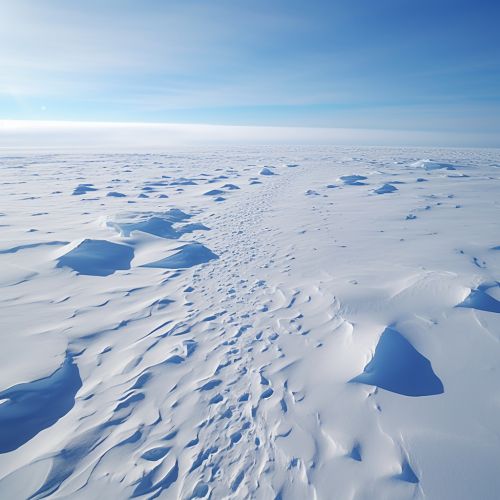Antarctic Ice Sheet Dynamics
Introduction
The Antarctic Ice Sheet is a significant component of the Earth's cryosphere, covering an area of approximately 14 million square kilometers. It is the largest single mass of ice on Earth and contains about 70% of the planet's fresh water. Understanding the dynamics of the Antarctic Ice Sheet is critical to predicting future sea-level rise, as changes in the ice sheet's mass balance can significantly influence global sea levels.


Structure and Composition
The Antarctic Ice Sheet is divided into two main components: the East Antarctic Ice Sheet (EAIS) and the West Antarctic Ice Sheet (WAIS). The EAIS is the larger of the two, covering about two-thirds of Antarctica, and is generally considered to be more stable due to its larger size and higher elevation. The WAIS, on the other hand, is more dynamic and potentially more susceptible to rapid ice loss.
The ice sheet is primarily composed of glacial ice, which is formed from the accumulation and compaction of snow. Over time, the weight of the accumulated snow causes the underlying layers to compress and form ice. This process, known as firnification, results in the formation of firn, a type of old snow that is in transition to becoming glacial ice.
Dynamics
The dynamics of the Antarctic Ice Sheet are governed by a complex interplay of various processes, including ice accumulation, ice flow, and ice loss. These processes are influenced by a range of factors, such as atmospheric and oceanic conditions, the underlying bedrock topography, and the internal properties of the ice itself.
Ice Accumulation
Ice accumulation on the Antarctic Ice Sheet primarily occurs through snowfall. The amount of snowfall varies across the continent, with coastal regions generally receiving more snowfall than the interior. Over time, this accumulated snow is compressed into ice, contributing to the growth of the ice sheet.
Ice Flow
Ice flow is a key process in the dynamics of the Antarctic Ice Sheet. The ice sheet flows from the interior towards the coast under the influence of gravity. This flow is facilitated by the internal deformation of the ice and basal sliding, where the ice sheet slides over the underlying bedrock.
The rate of ice flow varies across the ice sheet, with faster flow rates typically observed in ice streams and ice shelves. Ice streams are fast-flowing regions of ice that drain large areas of the ice sheet, while ice shelves are floating extensions of the ice sheet that extend over the ocean.
Ice Loss
Ice loss from the Antarctic Ice Sheet occurs primarily through two processes: surface melting and calving. Surface melting refers to the melting of the ice surface due to atmospheric warming, while calving refers to the breaking off of icebergs from the ice sheet's margin.
While surface melting is a relatively minor contributor to ice loss in Antarctica, it can significantly influence the stability of ice shelves. Calving, on the other hand, is a major contributor to ice loss, particularly from the WAIS.
Changes and Impacts
Changes in the dynamics of the Antarctic Ice Sheet can have significant impacts on global sea levels. Recent studies have shown that the ice sheet is losing mass at an accelerating rate, primarily due to increased ice loss from the WAIS. This increased ice loss is largely driven by oceanic warming, which enhances the melting of ice shelves and promotes ice flow.
In addition to contributing to sea-level rise, changes in the Antarctic Ice Sheet can also influence global climate patterns. For instance, the melting of the ice sheet can affect ocean circulation patterns, which in turn can influence global climate.
Future Projections
Future projections of the Antarctic Ice Sheet's dynamics are subject to considerable uncertainty, due to the complex interplay of various processes and feedbacks. However, most models project a continued loss of ice from the ice sheet in the coming centuries, which could significantly contribute to future sea-level rise.
Understanding and accurately predicting the future behavior of the Antarctic Ice Sheet remains a key challenge in climate science. Ongoing research efforts are focused on improving our understanding of the ice sheet's dynamics and refining models to better predict its future behavior.
